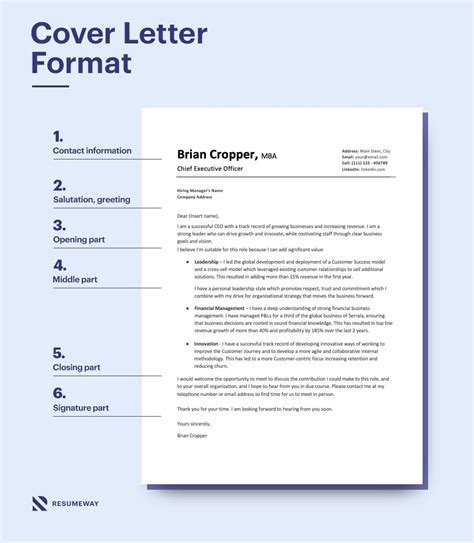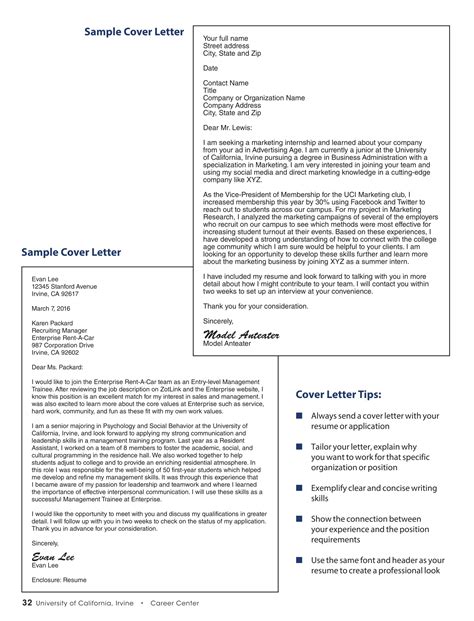How To Format A Cover Letter

A well-formatted cover letter is an essential tool in your job application toolkit, serving as your introduction to potential employers and highlighting your suitability for the role. With so many applications to review, recruiters often skim through cover letters, making a strong first impression crucial. This guide will walk you through the process of formatting a cover letter to ensure it captures attention and showcases your professionalism.
The Basics: Structure and Length

A cover letter should typically be one page long, structured with three main sections: an introduction, body paragraphs, and a conclusion. While it’s a concise document, each section has a distinct purpose and requires careful consideration.
Introduction
The introduction is your chance to grab the reader’s attention and set the tone for the rest of the letter. Begin with a strong opening statement that highlights your interest in the role and the company. Mention how you learned about the position and why you’re excited about it. For example, “I am writing to express my enthusiasm for the Marketing Coordinator role at [Company Name], which I discovered through [source]. Having followed the company’s innovative projects in [industry], I am particularly drawn to the opportunity to contribute to [specific aspect of the role].”
Follow this with a brief overview of your professional background and key qualifications. Provide a glimpse of your relevant skills and experiences that make you a strong fit for the position. For instance, "With a background in [field] and a proven track record in [relevant accomplishments], I believe I possess the necessary skills and knowledge to excel in this role."
Body Paragraphs
The body of your cover letter is where you delve into your qualifications and experiences in more detail. Use this space to showcase your unique skills and how they align with the job requirements. Each paragraph should focus on a specific skill or experience, with clear examples to illustrate your points.
For example, if you're applying for a content writer position, you might dedicate a paragraph to your writing abilities. Highlight your expertise in creating engaging content, your understanding of SEO strategies, and your experience with content management systems. Provide concrete examples of successful projects or campaigns you've worked on.
Similarly, if the role requires teamwork and collaboration, discuss your strong interpersonal skills and experiences working in diverse teams. Share how your ability to communicate effectively and build consensus has contributed to successful project outcomes in the past.
| Skill/Experience | Examples |
|---|---|
| Leadership | Mentored junior team members, leading a successful product launch |
| Problem-Solving | Identified and resolved a critical issue in a complex software system |
| Adaptability | Quickly adapted to changing project requirements, ensuring timely delivery |

Conclusion
In the conclusion, reiterate your enthusiasm for the role and company, and emphasize your eagerness to contribute to their success. Express your confidence in being a valuable asset to the team and provide a gentle nudge for the recruiter to take the next step, such as scheduling an interview.
For instance, "I am confident that my skills and experiences make me a strong candidate for the [position name] role. I am eager to discuss how my expertise can contribute to the company's [specific goal or project]. I look forward to the opportunity to further discuss my qualifications and learn more about the team's vision."
Formatting Tips and Tricks

While the content of your cover letter is crucial, the formatting can significantly impact its effectiveness. Here are some tips to ensure your cover letter is visually appealing and easy to read:
- Use a clear and simple font, such as Arial, Calibri, or Times New Roman, in a size between 10 and 12 points.
- Maintain a consistent font style and size throughout the letter.
- Left-align your text for a clean and professional look.
- Use bold, italics, and capitalization sparingly to emphasize key points or headings.
- Ensure proper spacing between paragraphs (1.5 or double-spacing is recommended) and a consistent margin size (typically 1 inch on all sides).
- Break up your letter into easily digestible sections using headings and bullet points where appropriate.
- Include your contact information at the top of the letter, along with your name, address, phone number, and email address.
- Use a professional email address that includes your name, such as firstname.lastname@example.com, rather than a personal one like email@example.com.
Additional Considerations
While the basic structure and formatting guidelines are essential, it’s also important to consider the specific requirements of the role and company you’re applying to. Tailor your cover letter to align with their values, mission, and the unique aspects of the position. Show that you’ve done your research and understand the company’s culture and goals.
For instance, if the company emphasizes innovation and creativity, showcase your ability to think outside the box and provide innovative solutions. If they value collaboration and teamwork, emphasize your strong interpersonal skills and experiences working in cohesive teams.
Furthermore, be sure to proofread your cover letter thoroughly for grammar and spelling errors. A single mistake can detract from the professionalism of your application. Consider using grammar-checking tools or asking a trusted friend or colleague to review your work.
Final Thoughts
A well-formatted cover letter is a powerful tool to showcase your professionalism and suitability for a role. By following the basic structure, paying attention to detail, and tailoring your content to the specific position and company, you can create a cover letter that stands out and increases your chances of landing an interview. Remember, a cover letter is your opportunity to make a strong first impression and showcase your unique value as a candidate.
How should I address the recruiter or hiring manager in my cover letter?
+It’s always best to address the recruiter or hiring manager by name if possible. You can typically find this information on the job posting or by contacting the company directly. If you’re unable to obtain their name, use a generic greeting like “Dear Hiring Manager” or “To Whom It May Concern.”
Should I include my salary expectations in the cover letter?
+In most cases, it’s not necessary to include salary expectations in your cover letter. This information is typically discussed during the interview process or in response to a specific request from the recruiter. Focus on highlighting your skills and experiences instead.
Can I reuse my cover letter for multiple job applications?
+While it’s tempting to save time by reusing a cover letter, it’s best to tailor each one to the specific job and company you’re applying to. This shows that you’re truly interested in the role and have taken the time to understand the company’s needs and culture.



